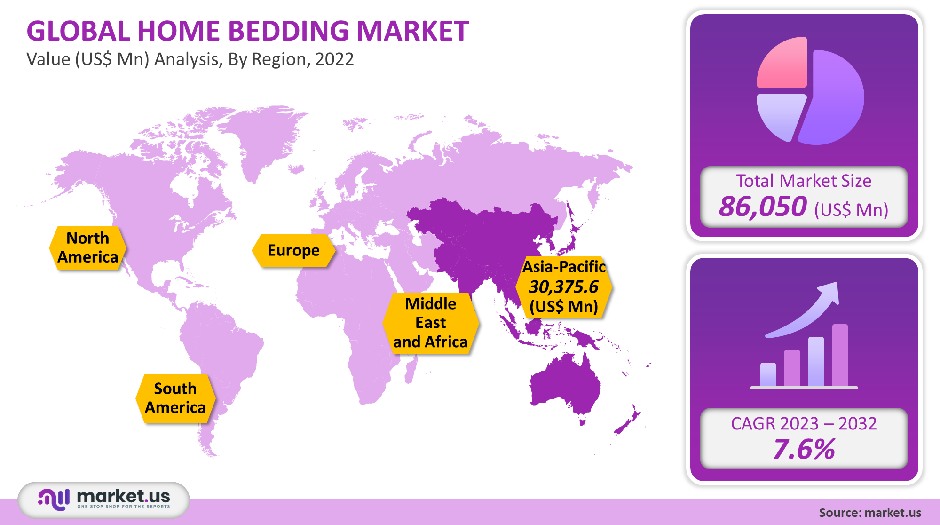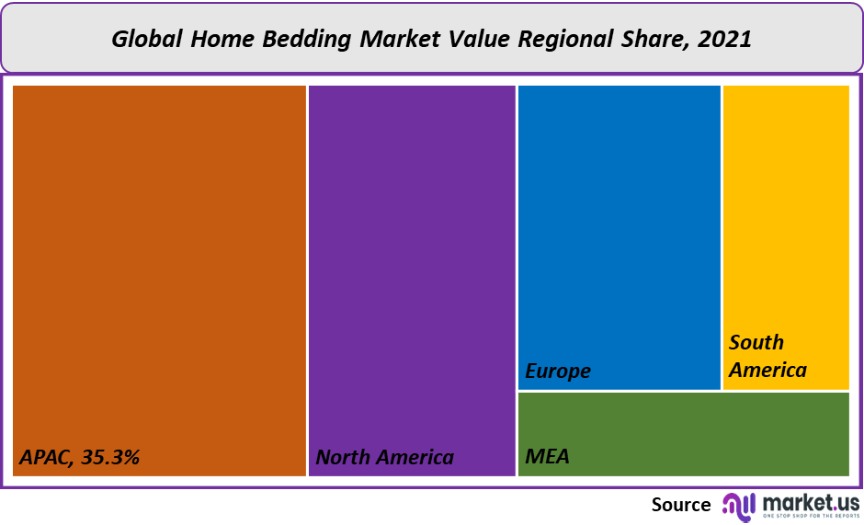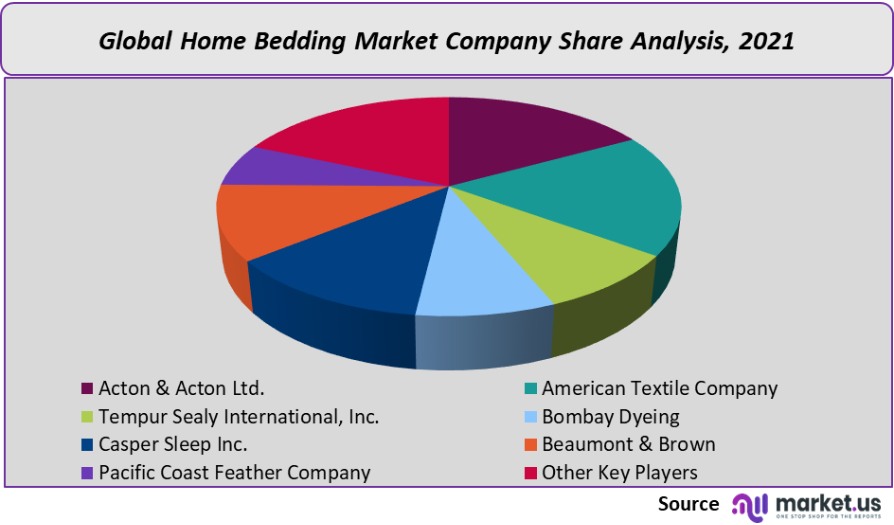Global Home Bedding Market By Type (Pillows, Bed Linen, Blankets, Mattress, and Others), By Distribution Channel (Offline and Online), By Region and Companies - Industry Segment Outlook, Market Assessment, Competition Scenario, Trends and Forecast 2022-2032
- Published date: May 2023
- Report ID: 43703
- Number of Pages: 370
- Format:
- keyboard_arrow_up
Quick Navigation
Home Bedding Market Overview:
The Home Bedding Market size is expected to be worth around US$ 1,63,050.80 million by 2031 from USD 86,050 million in 2022, growing at a CAGR of 7.6% during the forecast period 2021 to 2031.
The home bedding market report offers a complete analysis of Production analysis, segments, market dynamics, growth factors, regional analysis, competitive landscape, and market key players. The market has seen a boom in the housing sector and a rise in consumer spending on home furnishings.
Global Home Bedding Market Scope:
Type analysis
Bed linen dominated the market, accounting for over 24.2% of global home bedding market revenue in 2021. Bedding linens are bed sheets, duvet covers, pillow covers, and bed covers. The key to segment growth is the rapid shift in consumer preferences towards quality and sustainable linens that provide healthier and more comfortable beds.
From 2023 to 2032, the blankets market is expected to grow at 7.9%. This segment is driven by rising demand for Afghans from countries with cold climates like the U.K. and Canada. India is another country that sees high product demand, as some areas of India are subject to extreme cold. The segment is also seeing an increase in demand for premium and specialty linen and organic blankets, which are hypoallergenic and pesticide-free.

Distribution Channel Analysis
The market’s largest segments are online and offline channels, the offline distribution channel, accounted for over 64.7% of global home bedding market revenue in 2021. Shoppers prefer to shop offline as they can get a firsthand view of the products. This allows them to inspect the quality and materials. The brands were able to offer a unique shopping experience by using traditional brick-and-mortar stores.
Online distribution channels are expected to grow 9.3% annually between 2023 and 2032. Online retailers have made it easier for consumers to shop online and are less likely to visit brick-and-mortar shops. This could benefit both hybrid and online retailers, constantly looking for new ways to improve their fulfillment and distribution processes.
Кеу Маrkеt Ѕеgmеntѕ
By Type
- Pillows
- Bed Linen
- Mattress
- Blankets
- Others
By Distribution Channel
- Offline
- Online
Market Dynamics:
The COVID-19 epidemic has had devastating effects on the bedding industry. Online sales soared after the lockdown was announced. People had trouble getting enough sleep due to the changes in their routines. This upturn results from people looking for self-care solutions in a time of anxiety about COVID-19, which caused many sleep problems. This resulted in a rise in comfort and bedding spending, ultimately favoring the market growth.
The pandemic-related lockdowns in countries have prompted people to shift their budgets towards bedding. Many consumers are now working from home and have a better sleep environment. In 2021, mattress accessories such as back-supporting pillows and adjustable bases also gained popularity.
Jerry Epperson, a veteran in the mattress industry and managing director at Mann, Armistead & Epperson, a Virginia-based investment banking and corporate advisory company, said that October 2021 saw a more than 30.6% increase in sales year-over-year.
The Home Bedding Market trend is on the rise, with consumers placing more emphasis on the importance of quality sleep and comfortable living spaces. As a result, the market has seen a significant increase in demand for high-quality bedding products that cater to these needs. Manufacturers are responding to this trend by offering innovative designs, eco-friendly materials, and customizable options to cater to the diverse preferences of consumers. The rise of online shopping has also played a significant role in the growth of the market, making it easier than ever for consumers to access a wide range of bedding options from the comfort of their own homes. As the home bedding market trend towards sustainable and eco-friendly products continues to gain momentum, it is expected that the home bedding market will continue to grow in the coming years.
The increased demand for bedding products at home results from the improved performance of premium home bedding products. Also, the easy availability of premium quality products with various functional benefits attracts many customers to buy new home bedding. Superior quality bedding is also important because good sleep is essential for a healthy body and mind. The American Sleep Apnea Association estimates that between 50 and 70 million Americans have sleep-related problems. In addition, the rate of sleep deprivation in America has increased over the past 30 years.
Regional Analysis
The Asia Pacific was the dominant market, accounting for over 35.3% of global home bedding market revenue in 2021. The region’s dominant home textile market in countries like China, India, and Japan has led to a wide range of bedding textiles. This has allowed for increased application of bedding products in both residential and commercial areas.

Key Regions and Countries covered іn thе rероrt:
- North America
- US
- Canada
- Mexico
- Europe
- Germany
- UK
- France
- Italy
- Russia
- Spain
- Rest of Europe
- APAC
- China
- Japan
- South Korea
- India
- Rest of Asia-Pacific
- South America
- Brazil
- Argentina
- Rest of South America
- Middle East and Africa
- GCC
- South Africa
- Israel
- Rest of MEA
Competitive Landscape:
There are a few major players in the market and new entrants. To increase their customer base, companies have expanded their product ranges by adding innovative home bedding.
Some prominent players in the home bedding market are Acton & Acton Ltd., American Textile Company, West Point Home LLC, Hollander Sleep Products, Crane & Canopy Inc., Portico Inc., Wadia Group, and others.

Маrkеt Кеу Рlауеrѕ:
- Acton & Acton Ltd.
- American Textile Company
- Tempur Sealy International, Inc.
- Bombay Dyeing
- Branch LLC
- Beaumont & Brown Ltd
- Hollander, Kingsdown Inc.
- Serta Inc.
- Portico Inc.
- Boll & Branch LLC
- Casper Sleep Inc.
- Beaumont & Brown
- Pacific Coast Feather Company
- Other Key Players
For the Home Bedding Market research study, the following years have been considered to estimate the market size:
Attribute Report Details Historical Years
2016-2020
Base Year
2021
Estimated Year
2022
Short Term Projection Year
2028
Projected Year
2023
Long Term Projection Year
2032
Report Coverage
Competitive Landscape, Revenue analysis, Company Share Analysis, Manufacturers Analysis, Volume by Manufacturers, Key Segments, Key company analysis, Market Trends, Distribution Channel, Market Dynamics, COVID-19 Impact Analysis, strategy for existing players to grab maximum market share, and more.
Regional Scope
North America, Europe, Asia-Pacific, South America, Middle East & Africa
Country Scope
United States, Canada and Mexico, Germany, France, UK, Russia and Italy, China, Japan, Korea, India and Southeast Asia, Brazil, Argentina, Colombia etc.Saudi Arabia, UAE, Egypt, Nigeria and South Africa
Frequently Asked Questions (FAQ)
Whаt іѕ thе ѕіzе оf thе Ноmе Веddіng mаrkеt іn 2021?Тhе Ноmе Веddіng mаrkеt ѕіzе іѕ UЅ$ 86,050 mіllіоn іn 2021.
Whаt іѕ thе рrојесtеd САGR аt whісh thе Ноmе Веddіng mаrkеt іѕ ехресtеd tо grоw аt?Тhе Ноmе Веddіng mаrkеt іѕ ехресtеd tо grоw аt а САGR оf 7.6% between the forecast period 2023-2032.
Lіѕt thе ѕеgmеntѕ еnсоmраѕѕеd іn thіѕ rероrt оn thе Ноmе Веddіng mаrkеt?Маrkеt.UЅ hаѕ ѕеgmеntеd thе Ноmе Веddіng mаrkеt bу gеоgrарhіс (North America, Еurоре, АРАС, Central & Ѕоuth Аmеrіса, аnd the Middle East & Africa Country). Ву Туре, mаrkеt hаѕ bееn ѕеgmеntеd іntо Ріllоwѕ, Веd Lіnеn, Вlаnkеtѕ, Маttrеѕѕ, аnd Оthеrѕ. Ву Dіѕtrіbutіоn Сhаnnеl, thе mаrkеt hаѕ bееn furthеr dіvіdеd іntо Оfflіnе аnd Оnlіnе.
Lіѕt thе kеу іnduѕtrу рlауеrѕ оf thе Ноmе Веddіng mаrkеt?Acton & Acton Limited, Аmеrісаn Техtіlе Соmраnу, Теmрur Ѕеаlу Іntеrnаtіоnаl Іnс., Воmbау Dуеіng, Саѕреr Ѕlеер Іnс., Beaumont & Brown Ltd, Branch LLC, Расіfіс Соаѕt Fеаthеr Соmраnу, Crane & Canopy Inc., West Point Home LLC, Wadia Group, Peacock Alley аnd Оthеr Кеу Рlауеrѕ аrе thе kеу vеndоrѕ іn thе Ноmе Веddіng mаrkеt еngаgеd іn thе Ноmе Веddіng mаrkеt.
Whісh rеgіоn іѕ mоrе арреаlіng fоr vеndоrѕ еmрlоуеd іn thе Ноmе Веddіng mаrkеt?АРАС ассоuntеd fоr thе hіghеѕt rеvеnuе ѕhаrе оf 35.3%. Тhеrеfоrе, thе Ноmе Веddіng іnduѕtrу іn АРАС іѕ ехресtеd tо gаrnеr ѕіgnіfісаnt buѕіnеѕѕ орроrtunіtіеѕ оvеr thе fоrесаѕt реrіоd.
Nаmе thе kеу аrеаѕ оf buѕіnеѕѕ fоr Ноmе Веddіng?Сhіnа, Іndіа, Ѕоuth Коrеа, Gеrmаnу & Тhе UЅ, аrе kеу аrеаѕ оf ореrаtіоn fоr Ноmе Веddіng Маrkеt.
Whісh ѕеgmеnt ассоuntѕ fоr thе grеаtеѕt mаrkеt ѕhаrе іn thе Ноmе Веddіng іnduѕtrу?Wіth rеѕресt tо thе Ноmе Веddіng іnduѕtrу, vеndоrѕ саn ехресt tо lеvеrаgе grеаtеr рrоѕресtіvе buѕіnеѕѕ орроrtunіtіеѕ thrоugh thе оfflіnе ѕеgmеnt, аѕ thіѕ аrеа оf іntеrеѕt ассоuntѕ fоr thе lаrgеѕt mаrkеt ѕhаrе.

- Acton & Acton Ltd.
- American Textile Company
- Tempur Sealy International, Inc.
- Bombay Dyeing
- Casper Sleep Inc.
- Beaumont & Brown
- Pacific Coast Feather Company
- Other Key Players
- settingsSettings
Our Clients
| Single User $4,599 $3,499 USD / per unit save 24% | Multi User $5,999 $4,299 USD / per unit save 28% | Corporate User $7,299 $4,999 USD / per unit save 32% | |
|---|---|---|---|
| e-Access | |||
| Report Library Access | |||
| Data Set (Excel) | |||
| Company Profile Library Access | |||
| Interactive Dashboard | |||
| Free Custumization | No | up to 10 hrs work | up to 30 hrs work |
| Accessibility | 1 User | 2-5 User | Unlimited |
| Analyst Support | up to 20 hrs | up to 40 hrs | up to 50 hrs |
| Benefit | Up to 20% off on next purchase | Up to 25% off on next purchase | Up to 30% off on next purchase |
| Buy Now ($ 3,499) | Buy Now ($ 4,299) | Buy Now ($ 4,999) |











